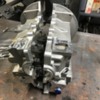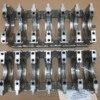I am hoping I can shed some light on your JPS troubles.
VW engines might last 100k in stock form. And that is a very slim possibility of might. Valve jobs and piston rings wouldn't last that long even in stock form. This engine was designed in the 1930s as cheap to maintain and replaceable. It is NOTHING like engines of today, machining tolerances and equipment are more precise today.
Ed Karyadi, you had the 2332cc from JPS, yes? I have personal experience with one of those, Tom Dewalt's from the same era. It may have been 2007, but I'm not 100% sure of exact year as his coupe was supposedly the first. I'm guessing it was the same engine builder. Kelly Frazer got the same thing and his is mechanically sound(but IDK mileage).
On Tom's car, the piston pin circlip came out and the piston pin rubbed the cylinder wall, destroying the cylinder. The engine ran mostly fine, but had a sooty spark plug and highly excessive oil consumption due to the eroded cylinder wall. I believe it was cylinder #2.
This happened from new, and it took a team, posted photos, and lots of social media commentary(pressure) to get John to do the right thing and warranty it. I personally disassembled this engine at Tom's place in Easton PA.
The fault was caused by either a defective piston pin circlip or improper installation ie: circlip not seated in groove. It can happen. If I built the engine, it would have teflon buttons, spiral locs or tru-arc clips in it instead of the cheesy ones that come with the barrel and jug kit.
The heads were stock and un-ported. It wasn't a high-dollar build and I'd be surprised if it was dynamically balanced or blueprinted in any way. It was put together, not carefully assembled by an engine builder.
I have a Jake Raby 2165cc type1 that I flog mercilessly since 2005. I replaced the pistons and barrels and had the valve guides replaced/valve job done at 35k. I sent the heads back to the builder Adrian at Headflow Masters. Normal wear, never split the case, just did a top end. It still runs flawlessly about 8k later after the 50% rebuild.
I would submit that a Pat Downs(or any other professional builder) can easily build a long lasting, balanced, and trouble-free VW engine. I would also submit that JPS did NOT do that in the late 2000s. I'm pretty surprised Eddy's engine lasted this long.
As far as the transmission, it sounds like you were lied to by sociopath John. It was probably a used trans thrown in there and sold as rebuilt. Or it got Chinese bearings, which in my experience don't last. Worst case, install some new bearings(mainshaft bearing is almost always the noise issue), synchros, adjust the shift forks, and back in it goes. And make sure that Rancho welds up 3rd and 4th.
The input shaft is supported by the pilot bearing in the gland nut, some movement is normal when the engine is out. The input shaft is held by a 6mm stud, a splined joint(reverse gear coupler), and a snap ring. I've seen the snap ring come out of its groove, causing the coupler to slide off and the 6mm stud to strip, unscrew, or snap. Always try to use new snap rings.
Replacing the engine is a bigger concern than the trans. The trans is relatively easy. Wishing you good luck in your refreshing efforts, Any additional help I can be, let me know.
If your mechanic is rebuilding the engine, I'd suggest CB Performance for most parts. These days, getting the rotating mass balanced(crank, flywheel, pressure plate, and crank pulley) is important. Also, balancing the pistons/pins to the gram and the rods end-for-end. CBs CNC heads are pretty good, especially for the money. ALWAYS get the CB CNC port-matched manifolds for the heads you get. I prefer Webcam camshafts and either Webcam or Scat lifters. Once you decide on displacement, cam and rockers (ratio) then you can determine chamber volume(and compression ratio).
Cheers.


 i like ed's car
i like ed's car  happy motoring
happy motoring 




















